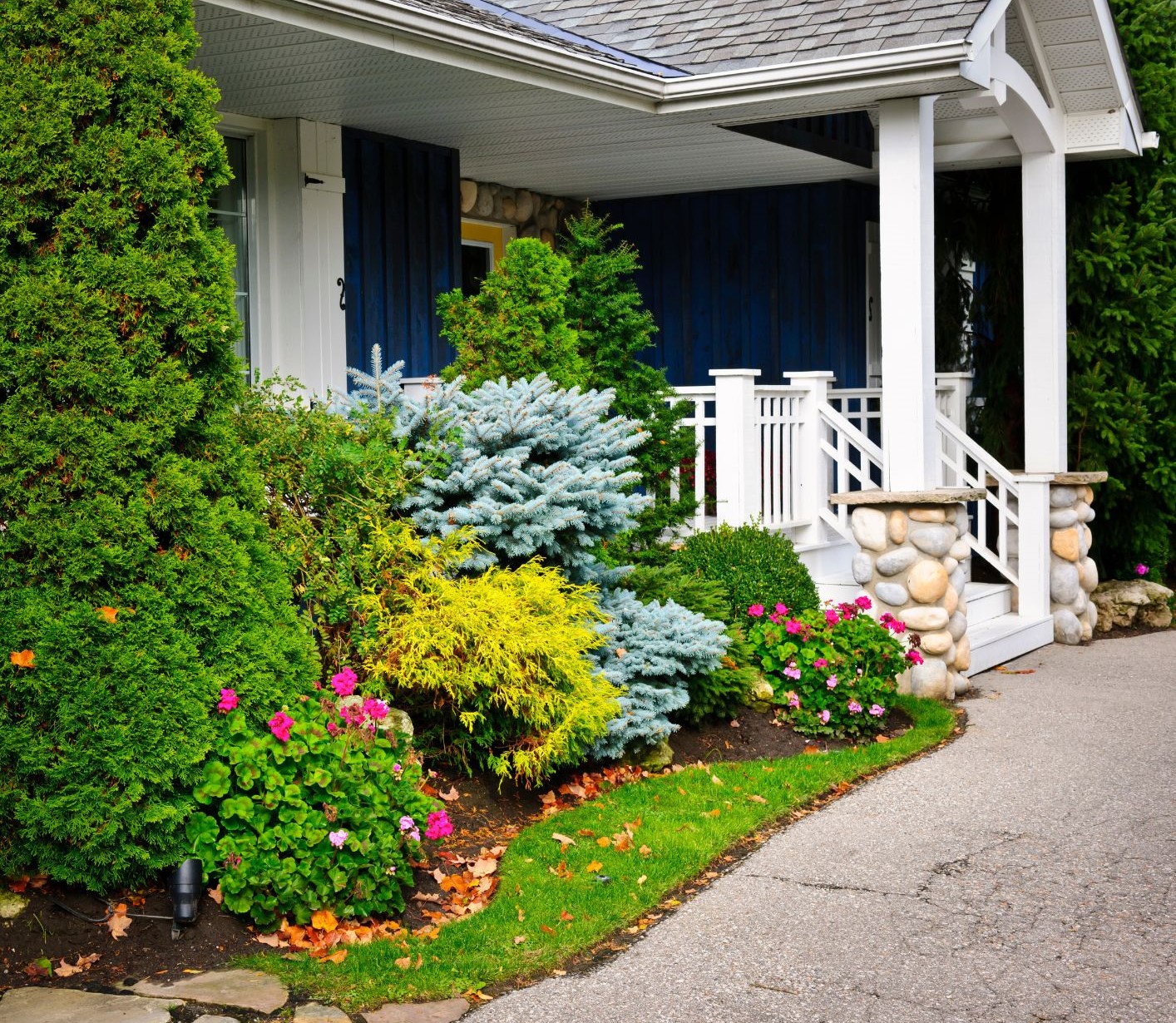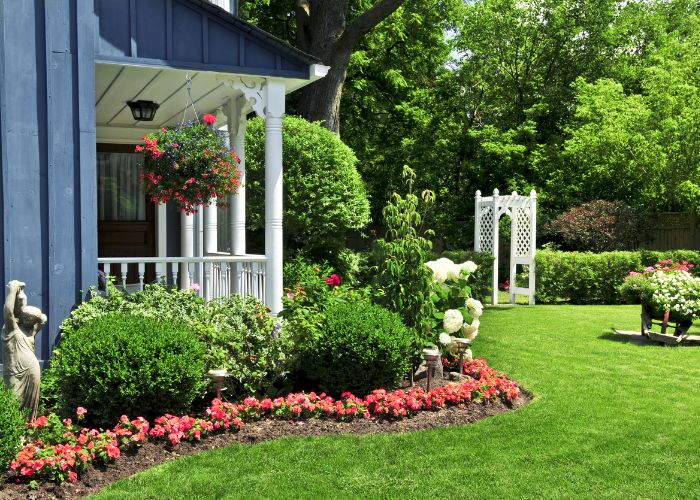Garden Just Outside an Entrance
Gardens just outside an entrance can set the tone for the entire space. They can create a sense of welcome and peace, or they can be used to make a bold statement. In this blog post, we'll discuss the importance of gardens just outside an entrance and provide some tips on how to create the perfect one for your space.

Garden Just Outside an Entrance

The first impression is often the most important, and this is especially true when it comes to your home or business. A well-designed garden just outside an entrance can set the tone for the entire space and make a lasting impression on visitors.
The benefits of gardens just outside an entrance:
Gardens can create a sense of welcome and peace. When people first arrive at your space, they should feel welcomed and at ease. A garden can help to create this atmosphere by providing a lush and inviting space to relax and enjoy.
Gardens can be used to make a bold statement. If you're looking to make a statement with your home or business, a garden can be a great way to do it. Gardens can help to improve air quality. Plants can help to filter out pollutants from the air, making your space cleaner and healthier to breathe in.
Gardens can attract wildlife. Birds, butterflies, and other animals are drawn to gardens, which can add a touch of nature to your space.
Choose plants that are unique or colorful, or arrange them in a way that is visually striking.
What Plants Can I Use for My Garden?
If you're living it up in Santa Clara County, finding plants that thrive in our weather conditions is key. The United States Department of Agriculture has split the US into different climate-based growing zones (hardiness zones) to figure out which plants will thrive in different areas. So, according to the USDA Hardiness Zone Map, Zone 9 is where it's at in the southern region of the US. It's got mild temperatures, perfect for growing a variety of plants.
Zone 9 is the place to be if you love long, hot summers and extended growing seasons that last from February all the way to December. With its sunny and warm conditions, Zone 9 is an ideal section for creating a winter garden and nurturing heat-tolerant plants in the summer. We're talking veggies, flowering shrubs, herbs, and even citrus and fruit trees—they all thrive in Zone 9. But keep in mind that extra cold-hardy plants might struggle with the summer heat in this area.
Now, Zone 9 includes some states like Florida, Georgia, Texas, California, and even Hawaii. Each USDA Hardiness Zone has two subsets. So within Zone 9, we've got Zone 9a and Zone 9b, each varying by five degrees Fahrenheit.
What's the planting schedule for Zone 9?
Well, here's the scoop: the growing season runs from February to December, with the first winter frost hitting around mid-December and the last frost saying goodbye in late February. Of course, these dates can dance around a bit depending on the weather in your local area.
Now, if you want to get your green thumbs going, here's a general rule to follow. Start by planting the seeds of a new plant indoors before the last frost (around early February), and once that frost has done its thing, it's time to transfer those little sprouts outside.
Now, let's talk about what plants to grow in the USDA Hardiness Zone 9. This zone loves plants that can handle a bit of drought and soak up the sun. Since Zone 9 covers a range of temperate climates, many plant species can thrive here. But keep in mind that microclimates exist within Zone 9, meaning small variations in climate conditions. Things like sun and wind can impact these microclimates. So, before adding a new plant to your backyard or garden, take those microclimate factors into consideration.
Here are some plant suggestions that thrive in Zone 9
Succulents
These cacti generally thrive in USDA Zone 9. The warm and sunny climate of Zone 9 provides favorable conditions for many succulent varieties to grow and thrive. Succulents are known for their ability to store water in their leaves, stems, or roots, allowing them to withstand periods of drought. This makes them well-suited for the dry and arid conditions often found in Zone 9 regions. However, it's important to note that while succulents can tolerate heat and drought, they still require proper care and attention, such as well-draining soil and occasional watering. With the right conditions and care, succulents can be a great addition to your garden or indoor space in USDA Zone 9.
Succulents species that can thrive in USDA Zone 9:
- • Aloe vera: A popular succulent known for its medicinal properties and gel-filled leaves.
• Echeveria: This genus includes a variety of rosette-shaped succulents with vibrant colors and unique textures.
• Sedum: With a wide range of species, sedums are versatile and hardy succulents that come in various shapes, sizes, and colors.
• Agave: These striking succulents have dramatic and architectural rosettes and are well-suited to warm and arid climates.
• Crassula: Commonly known as "jade plants," crassulas are compact succulents with fleshy leaves and can be grown both indoors and outdoors.
• Kalanchoe: This genus offers a diverse selection of succulents with beautiful blooms, making them a popular choice for Zone 9 gardens.
• Sempervivum: Also known as "hens and chicks," sempervivums are small, low-growing succulents that form clusters and are highly drought-tolerant.
• Graptopetalum: These succulents feature rosettes of thick, plump leaves in various shades of green, blue, and purple.
Begonias
These flowering perennials are all about colorful blooms and lush green foliage. They're all about that warm climate life (like in Zone 9), but they prefer a bit of shade rather than direct sunlight. Find a shady spot in your garden for these showstoppers.
Chives
Spice things up in your Zone 9 herb garden by growing zesty chives. These babies love warm temps, full sun, and well-draining soil. They come back year after year, giving you plenty of culinary herbs to enhance your soups, stews, and other delicious dishes.
Hibiscus
These flowers are all about making a statement with their vibrant and eye-catching blooms. From bright pink to dark purple, hibiscus offers a range of sunset-inspired colors. Some species can handle colder temps, but most prefer the high heat of warm, sunny climates like Zone 9. Keep those flowers hydrated and regularly remove old blooms to make room for new ones.
Irises
These beauties come in various colors and grow from bulbs or rhizomes. Irises have soft inner petals surrounded by sturdier outer petals. They're either bearded or crested, with their own unique features. Irises are tough and can handle drought conditions, making them a great choice for your Zone 9 garden. Plus, they're a magnet for hummingbirds and bees, bringing some lively pollinators to your space.
Peonies
These flashy flowers steal the show with their large, layered blooms. While most peonies love full sun, others, like tree peonies, prefer some shade. The great thing is, peonies can handle various weather conditions, making them suitable for both Zone 4 and Zone 9 gardens.
Roses
In most planting zones, roses only grace us with their beauty for a few months. But in Zone 9, roses are the gift that keeps on giving all year round. You can grow any type of rose in this zone, but make sure to choose a spot with well-drained soil and ample sunlight for them to flourish.
So there you have it—some top-notch plants that thrive in USDA Hardiness Zone 9. From showy flowers to herbs, your garden will be bursting with life and color. Get ready to enjoy the rewards of gardening in our sunny, warm climate!
Tips for creating the perfect garden just outside an entrance:
• Choose plants that are appropriate for the climate and amount of sunlight in your area.
• Consider the size of your space and choose plants that will not outgrow it.
• Use a variety of plants to create interest and depth.
• Add some hardscaping elements, such as a path, bench, or fountain, to complete the look.
Gardens just outside an entrance can be a great way to enhance your home or business. By following the tips above, you can create a beautiful and inviting space that will make a lasting impression on visitors. Don't hesitate to buy online with us your plants for your garden. Check here some of the plants available or feel free to call us at (408) 378-4046 or visit us as our store in Gilroy. We've got you covered with our same-day delivery service in Santa Clara County.

